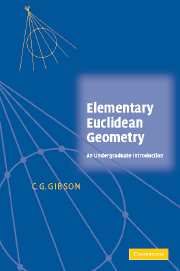Book contents
- Frontmatter
- Contents
- List of Figures
- List of Tables
- Preface
- Acknowledgements
- 1 Points and Lines
- 2 The Euclidean Plane
- 3 Circles
- 4 General Conics
- 5 Centres of General Conics
- 6 Degenerate Conics
- 7 Axes and Asymptotes
- 8 Focus and Directrix
- 9 Tangents and Normals
- 10 The Parabola
- 11 The Ellipse
- 12 The Hyperbola
- 13 Pole and Polar
- 14 Congruences
- 15 Classifying Conics
- 16 Distinguishing Conics
- 17 Uniqueness and Invariance
- Index
1 - Points and Lines
Published online by Cambridge University Press: 06 July 2010
- Frontmatter
- Contents
- List of Figures
- List of Tables
- Preface
- Acknowledgements
- 1 Points and Lines
- 2 The Euclidean Plane
- 3 Circles
- 4 General Conics
- 5 Centres of General Conics
- 6 Degenerate Conics
- 7 Axes and Asymptotes
- 8 Focus and Directrix
- 9 Tangents and Normals
- 10 The Parabola
- 11 The Ellipse
- 12 The Hyperbola
- 13 Pole and Polar
- 14 Congruences
- 15 Classifying Conics
- 16 Distinguishing Conics
- 17 Uniqueness and Invariance
- Index
Summary
Lines play a fundamental role in geometry. It is not just that they occur widely in the analysis of physical problems – the geometry of more complex curves can sometimes be better understood by the way in which they intersect lines. For some readers the material of this chapter will be familiar from linear algebra, in which case it might be best just to scan the contents and proceed to Chapter 2. Even so, you are advised to look carefully at the basic definitions. It is worth understanding the difference between a linear function and its zero set: it may seem unduly pedantic, but blurring the distinction introduces a potential source of confusion. Much of this text depends on the mechanics of handling lines efficiently and for that reason Section 1.4 is devoted to practical procedures. In Section 1.5 we consider lines from the parametric viewpoint, which will be of use later when we look at the properties of conics in more detail. Finally, we go one step further by considering pencils of lines, which will play a key role in introducing axes in Chapter 7.
The Vector Structure
Throughout this text ℝ will denote the set of real numbers. For linguistic variety we will refer to real numbers as constants (or scalars). We will work in the familiar real plane ℝ2 of elementary geometry, whose elements Z = (x, y) are called points (or vectors).
- Type
- Chapter
- Information
- Elementary Euclidean GeometryAn Introduction, pp. 1 - 11Publisher: Cambridge University PressPrint publication year: 2004



